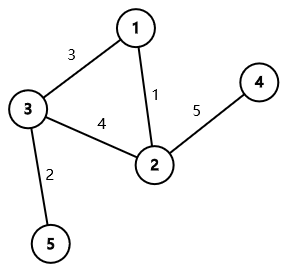CF1707C.DFS Trees
普及/提高-
通过率:0%
AC君温馨提醒
该题目为【codeforces】题库的题目,您提交的代码将被提交至codeforces进行远程评测,并由ACGO抓取测评结果后进行展示。由于远程测评的测评机由其他平台提供,我们无法保证该服务的稳定性,若提交后无反应,请等待一段时间后再进行重试。
题目描述
You are given a connected undirected graph consisting of n vertices and m edges. The weight of the i -th edge is i .
Here is a wrong algorithm of finding a minimum spanning tree (MST) of a graph:
<pre class="verbatim"><br></br>vis := an array of length n<br></br>s := a set of edges<br></br><br></br>function dfs(u):<br></br> vis[u] := true<br></br> iterate through each edge (u, v) in the order from smallest to largest edge weight<br></br> if vis[v] = false<br></br> add edge (u, v) into the set (s)<br></br> dfs(v)<br></br><br></br>function findMST(u):<br></br> reset all elements of (vis) to false<br></br> reset the edge set (s) to empty<br></br> dfs(u)<br></br> return the edge set (s)<br></br>
Each of the calls findMST(1), findMST(2), ..., findMST(n) gives you a spanning tree of the graph. Determine which of these trees are minimum spanning trees.
输入格式
The first line of the input contains two integers n , m ( 2≤n≤105 , n−1≤m≤2⋅105 ) — the number of vertices and the number of edges in the graph.
Each of the following m lines contains two integers ui and vi ( 1≤ui,vi≤n , ui=vi ), describing an undirected edge (ui,vi) in the graph. The i -th edge in the input has weight i .
It is guaranteed that the graph is connected and there is at most one edge between any pair of vertices.
输出格式
You need to output a binary string s , where si=1 if findMST(i) creates an MST, and si=0 otherwise.
输入输出样例
输入#1
5 5 1 2 3 5 1 3 3 2 4 2
输出#1
01111
输入#2
10 11 1 2 2 5 3 4 4 2 8 1 4 5 10 5 9 5 8 2 5 7 4 6
输出#2
0011111011
说明/提示
Here is the graph given in the first example.
 There is only one minimum spanning tree in this graph. A minimum spanning tree is (1,2),(3,5),(1,3),(2,4) which has weight 1+2+3+5=11 .
There is only one minimum spanning tree in this graph. A minimum spanning tree is (1,2),(3,5),(1,3),(2,4) which has weight 1+2+3+5=11 .
Here is a part of the process of calling findMST(1):
- reset the array vis and the edge set s;
- calling dfs(1);
- vis[1] := true;
- iterate through each edge (1,2),(1,3) ;
- add edge (1,2) into the edge set s, calling dfs(2):
- vis[2] := true
- iterate through each edge (2,1),(2,3),(2,4) ;
- because vis[1] = true, ignore the edge (2,1) ;
- add edge (2,3) into the edge set s, calling dfs(3):
- ...
In the end, it will select edges (1,2),(2,3),(3,5),(2,4) with total weight 1+4+2+5=12>11 , so findMST(1) does not find a minimum spanning tree.
It can be shown that the other trees are all MSTs, so the answer is 01111.